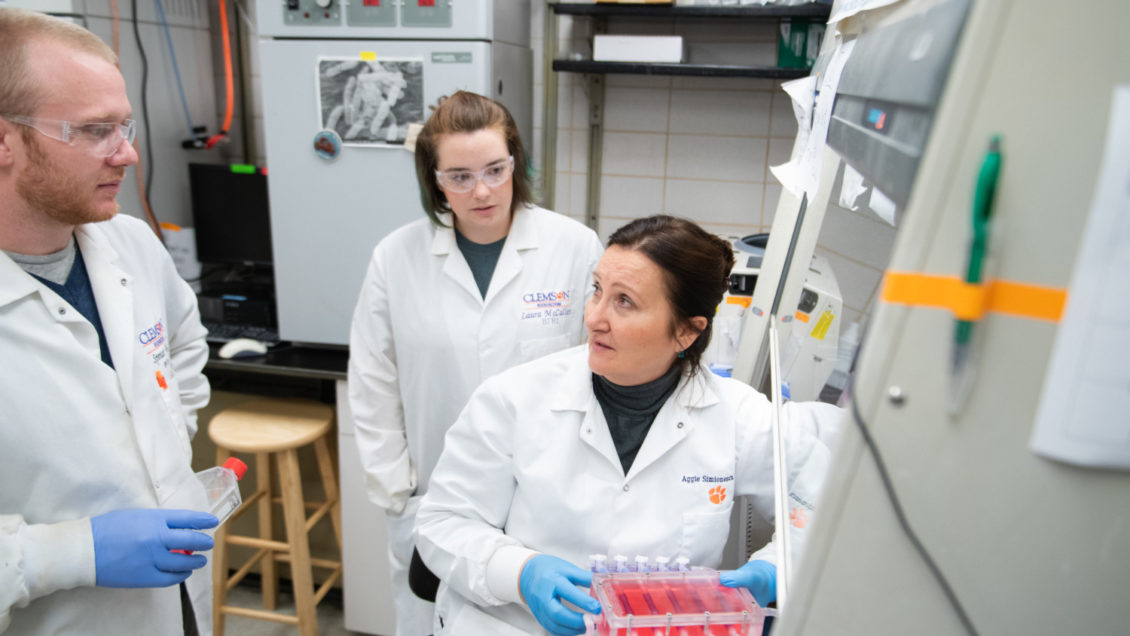CLEMSON — Clemson University bioengineers are launching a new research project to better understand cardiovascular disease in patients with diabetes, an affliction that affects about 13 percent of South Carolina adults and cost $4.3 billion last year alone.
What the bioengineers learn could help lay the groundwork for future studies aimed at finding new treatments.

The Clemson research will be led by Agneta Simionescu, an associate professor in the bioengineering department. She announced Monday that the National Institutes of Health is providing $1.38 million for her research.
The impact could be huge, particularly in South Carolina, where 13 percent of of adults reported that a health professional told them they have diabetes, according to a report last year by the United Health Foundation. That was sixth highest in the nation.
Simionescu’s project sharpens the focus on atherosclerosis, a condition that accelerates in diabetics.
The condition occurs when plaques made of cholesterol, cell debris, calcium, and other substances build up on blood vessel walls, threatening blood flow. Plaque narrows arteries and has the potential to rupture and cause blockages, which could result in heart attack and stroke.
Simionescu and her team are concentrating on the role of fibroblasts in atherosclerosis.
When blood vessels are damaged, fibroblasts are deployed to make repairs by synthesizing collagen. But in diabetics, fibroblasts produce too much collagen. The vascular tissue becomes “fibrotic” and calcifies, researchers said.
“The whole blood vessel becomes stiffer, and that’s the hallmark of diabetes,” Simionescu said.
The Simionescu team is drawing from its experience in tissue engineering to learn more. They will use three-dimensional models to study how fibroblasts communicate with two types of cells in blood vessel walls, endothelial cells and smooth muscle cells, both factors in atherosclerosis.
“Fibroblasts would not know what to do unless they get a signal from an endothelial cell or a smooth muscle cell,” Simionescu said. “They need to interact with each other. That’s what is hard to determine.”
When researchers create their models, they will start with pig arteries that have been thoroughly stripped of their cells. What’s left are elastin-and-collagen scaffolds that maintain the tubular structure of blood vessels.
Researchers will inject human endothelial cells into a scaffold. Within a few hours, the endothelial cells will naturally spread throughout the scaffold.
Then researchers will then inject fibroblasts. Bioreactors will be used to simulate vascular biomechanics and diabetic conditions.
“We will be able to tell at the end of the experiment if endothelial cells send a signal to fibroblasts,” Simionescu said.
Researches will also try the same experiment in different scaffolds but use smooth-muscle cells instead of endothelial cells.
The models “could provide powerful toolboxes for diabetes basic research and drug screening systems,” Simionescu said.
“In tissue engineering, if you are able to mimic blood vessels, then you can do drug testing on them,” she said. “You don’t necessarily have to do those tests on animals, which would not respond the same as human cells anyway. This is the advantage of using tissue-engineering-based models.”
In South Carolina, 577,000 people have diabetes, and another 1.32 million have prediabetes, according to the American Diabetes Association. Nationally, more than 100 million Americans have diabetes or prediabetes, according to the Centers for Disease Control and Prevention.
Medical expenses for people with diabetes are about 2.3 times higher than people without diabetes, the American Diabetes Association reported. Total direct medical expenses for diagnosed diabetes in South Carolina were estimated at $4.3 billion in 2017, according to the association.
Martine LaBerge, chair of the Department of Bioengineering, said Simionescu’s work was made possible by a grant through the National Institutes of Health’s R01 program.
“Dr. Simionescu’s grant is a testament to the level of scholarship and the innovative ideas she brings to bioengineering and health research at Clemson,” LaBerge said. “I congratulate her on this prestigious accomplishment.”
Simionescu said her project takes diabetes research beyond previous studies that focused on two-dimensional monolayers of cells. The monolayer studies were limited because cells in the human body grow in three dimensions instead of two, meaning several factors including cell communication could not be studied.
Anand Gramopadhye, dean of the College of Engineering, Computing and Applied Sciences said Simionescu’s grant helps raise the research profile of the college.
“She is pushing the boundaries of health innovation to have a real impact on diabetes, one of the greatest health care challenges of our time,” he said. “I congratulate her on this well-deserved honor.”
END
Get in touch and we will connect you with the author or another expert.
Or email us at news@clemson.edu

